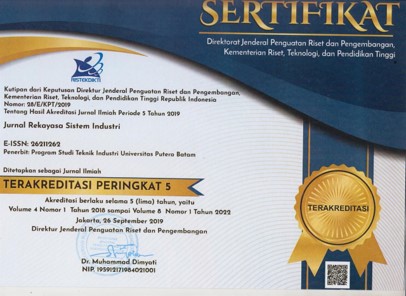ANALISA BULLWHIP EFFECT PENGADAAN STOCK FRANCHISE AYAM SABANA
DOI:
https://doi.org/10.33884/jrsi.v7i1.4461Keywords:
bullwhip effect, inventory, Single Exponential Smoothing.Abstract
The COVID-19 pandemic made some companies must pay attention to all their business needs appropriately and measurably. Strategic use in some companies there is making the limited on the stock supply, it is expected to reduce the losses that will be experienced by business people. The Sabana franchise has problems in determining the optimal safety stock so that there is no bullwhip effect in the supply chain for these raw materials. The purpose of this study is to determine the value, causes, and proposed solutions to reduce the occurrence of the Bullwhip Effect and can optimally forecast inventory requirements using the Single Exponential Smoothing method. The results obtained from this study are the magnitude of the bullwhip effect that occurs in the supply chain Franchise Sabana, which has a value of 1.036 and the value is greater than 1. which means that there has been a Bullwhip effect on the observed supply chain. From the analysis results, it is known that the causes of the Bullwhip effect include the absence of system users and strategies in forecasting needs, unmeasured supply or inventory shortages, fluctuating price fluctuations, order sizes, and order fulfillment grace periods, and forecasting results for inventory in the next month. of 663.6 kg with a minimum stock limit of 351.7 kg and a maximum stock limit of 975.6 kg. Ways that may be effective to reduce the bullwhip effect that occurs include managing product availability properly, namely by applying forecasting on controlled sales of raw material orders and also the accuracy of information from product sales so that business owners will find it easy to calculate forecasting values for the period to come. come to be able to optimally and efficiently in financing business activities.
References
Alfarisi, S. (2017). Sistem Prediksi Penjualan Gamis Toko QITAZ Menggunakan Metode Single Exponential Smoothing. JABE (Journal of Applied Business and Economic), 4(1), 80. https://doi.org/10.30998/jabe.v4i1.1908
Arina, A. E. F., & Lukmandono. (2017). Penerapan Metode Model Autoregressive Integrated Moving Average Guna Mengurangi Terjadinya Bullwhip Effect Pada Supply Chain. Seminar Nasional Sains Dan Teknologi Terapan, 161–166.
Hikmawati, E. (2019). Penjualan Obat Pada Apotek Pusat Dan Cabang. NARATIF (Jurnal Ilmiah Nasional Riset Aplikasi Dan Teknik Informatika, 1(1), 1–8.
Heizer, J., & Render, B. (2015). Manajemen Operasi Edisi 11. Jakarta: Salemba Empat.
Nurlifa, A., & Kusumadewi, S. (2017). Sistem Peramalan Jumlah Penjualan Menggunakan Metode Moving Average Pada Rumah Zaky. INOVTEK Polbeng - Seri Informatika, 2(1), 18. https://doi.org/10.35314/isi.v2i1.112
Siti Juriah. (2020). Break Even Point Analysis on Sabana Fried Chicken Jatirahayu Outlet, Bekasi. Literature for Social Impact and Cultural Studies, Vol. 2(2), pp. 141–148.
Stevenson, W. J., & Shoung, S. C. (2013). Operations Management: an Asian Perspective. Jakarta: Salemba Empat.
Yanti, N. P. L. P., Tuningrat, I. . M., & Wiranatha, A. A. P. A. S. (2016). Analisis Peramalan Penjualan Produk Kecap Pada Perusahaan Kecap Manalagi Denpasar Bali. Jurnal Rekayasa Dan Manajemen Agroindustri, 4(1), 72–81.
Downloads
Published
Issue
Section
License

This work is licensed under a Creative Commons Attribution-NonCommercial-ShareAlike 4.0 International License.
















